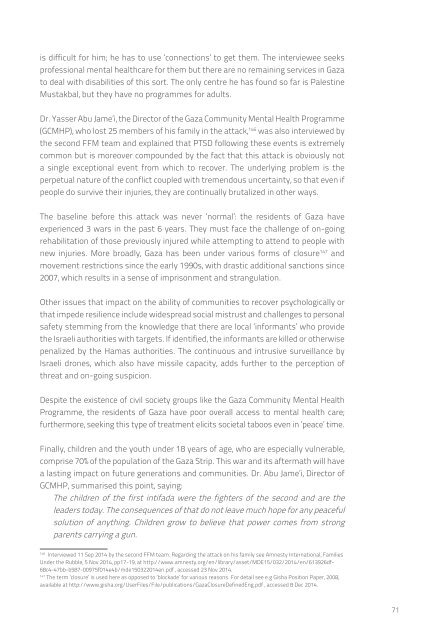HHo0s
HHo0s
HHo0s
You also want an ePaper? Increase the reach of your titles
YUMPU automatically turns print PDFs into web optimized ePapers that Google loves.
is difficult for him; he has to use ‘connections’ to get them. The interviewee seeksprofessional mental healthcare for them but there are no remaining services in Gazato deal with disabilities of this sort. The only centre he has found so far is PalestineMustakbal, but they have no programmes for adults.Dr. Yasser Abu Jame’i, the Director of the Gaza Community Mental Health Programme(GCMHP), who lost 25 members of his family in the attack, 146 was also interviewed bythe second FFM team and explained that PTSD following these events is extremelycommon but is moreover compounded by the fact that this attack is obviously nota single exceptional event from which to recover. The underlying problem is theperpetual nature of the conflict coupled with tremendous uncertainty, so that even ifpeople do survive their injuries, they are continually brutalized in other ways.The baseline before this attack was never ‘normal’: the residents of Gaza haveexperienced 3 wars in the past 6 years. They must face the challenge of on-goingrehabilitation of those previously injured while attempting to attend to people withnew injuries. More broadly, Gaza has been under various forms of closure 147 andmovement restrictions since the early 1990s, with drastic additional sanctions since2007, which results in a sense of imprisonment and strangulation.Other issues that impact on the ability of communities to recover psychologically orthat impede resilience include widespread social mistrust and challenges to personalsafety stemming from the knowledge that there are local ‘informants’ who providethe Israeli authorities with targets. If identified, the informants are killed or otherwisepenalized by the Hamas authorities. The continuous and intrusive surveillance byIsraeli drones, which also have missile capacity, adds further to the perception ofthreat and on-going suspicion.Despite the existence of civil society groups like the Gaza Community Mental HealthProgramme, the residents of Gaza have poor overall access to mental health care;furthermore, seeking this type of treatment elicits societal taboos even in ‘peace’ time.Finally, children and the youth under 18 years of age, who are especially vulnerable,comprise 70% of the population of the Gaza Strip. This war and its aftermath will havea lasting impact on future generations and communities. Dr. Abu Jame’i, Director ofGCMHP, summarised this point, saying:The children of the first intifada were the fighters of the second and are theleaders today. The consequences of that do not leave much hope for any peacefulsolution of anything. Children grow to believe that power comes from strongparents carrying a gun.146Interviewed 11 Sep 2014 by the second FFM team. Regarding the attack on his family see Amnesty International, FamiliesUnder the Rubble, 5 Nov 2014, pp17-19, at http://www.amnesty.org/en/library/asset/MDE15/032/2014/en/613926df-68c4-47bb-b587-00975f014e4b/mde150322014en.pdf , accessed 23 Nov 2014.147The term ‘closure’ is used here as opposed to ‘blockade’ for various reasons. For detail see e.g Gisha Position Paper, 2008,available at http://www.gisha.org/UserFiles/File/publications/GazaClosureDefinedEng.pdf , accessed 8 Dec 2014.71


